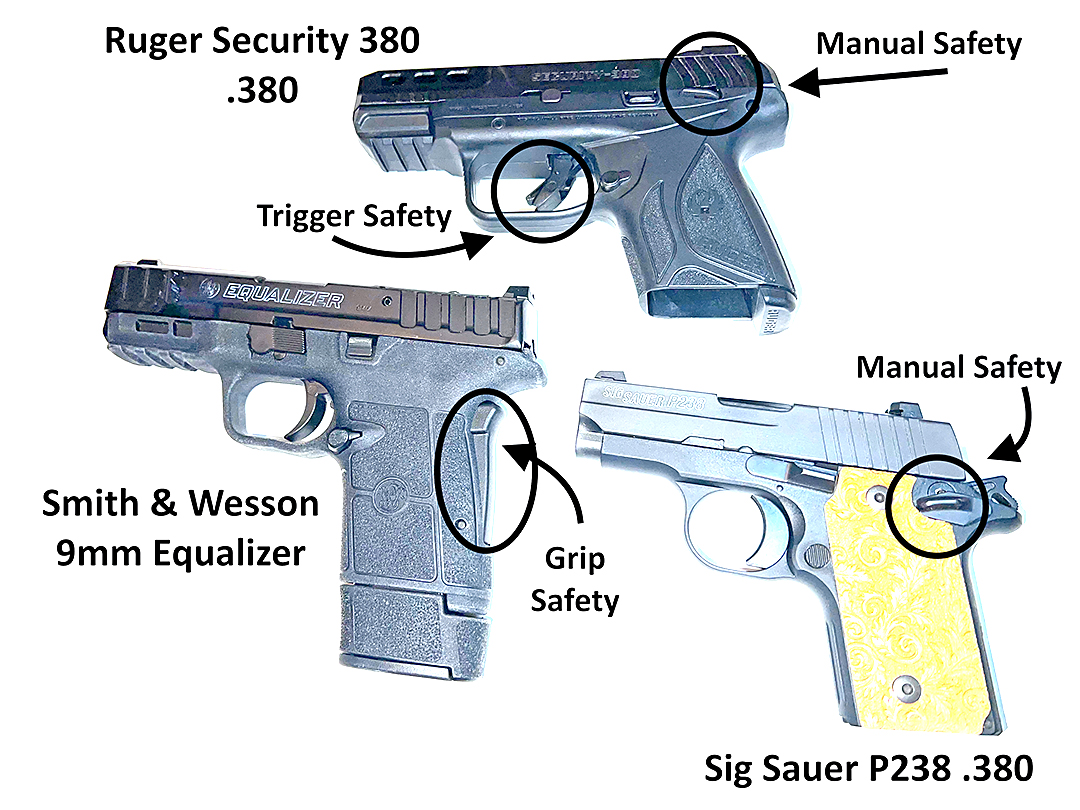Safety or no?

By MARJ LAW

Joe and I continue to have a… discussion about safeties on handguns.
“When I was in the Navy, Master Chief Gunner’s Mate Do-It-The-Hard-Way says that all handguns should have an external safety and that using it has to be in your automatic muscle memory. This reduces the possibility of accidental discharge,” says Joe.
Oh, yawn.
That was how many decades ago? Times have changed. I assert that a safety is the last thing a mature person wants on his or her new handgun. In fact, I’d go so far as to say a safety is anything but safe.
OK. Now you old geezers are up in arms, and I don’t know what I’m talking about.
Yes, I’d agree you need all the safe you can get when you’re trying to teach 18-24 year-old guys just coming into the service. (Back then, it was just guys.) At that age, they know they’ll live forever. But Master Chief has to be hard and definite on certain procedures so that maybe they’ll have a chance to grow into adulthood.
“Sliding your thumb down on the safety should be automatic when you draw your gun,” Joe pontificates.
That was then and this is now.
Now we’re talking about mature people who are not used to guns or newbies who are also not used to guns, but who are learning. Do you want your spouse to have to face Mr. Bad while wondering:
“The gun is loaded and I’m scared to death. Did I put the safety on? Does that little lever flip up or down? And, let me see… Which is the correct lever?”
I’d rather know that the threatened person should be secure that he can point that handgun, fire, and defend himself.
This doesn’t mean that I don’t believe in safeties. I sure do. Today, there are several different kinds of built-in safeties that you might not even notice.
Yes, usually you can have the option of having or not having a manual safety when you purchase a handgun. But depending on the gun you choose, there are several other safeties to prevent accidental firing.
One is a grip safety.
I like this one. It’s built into the back of the grip. When you grab your gun, you must have a good and secure grip, getting the web of your hand (the part between thumb and forefinger) high up and pushing into the grip. If you are not holding the gun securely, the gun is unable to fire. Holding the gun by the grip alone is not sufficient. Your handhold must be firm and secure.
The Smith & Wesson M&P .380 Shield EZ has a grip safety. So does the Smith & Wesson 9mm Equalizer. I like these both for defense.
Another kind of safety that you can see looks like a second trigger.
It’s a small lever in front of the trigger. If this is not depressed, the gun is unable to fire. The Canic TP9 Elite has one of these.
Some safeties that you can’t see are built into the gun. One is a long trigger travel.
A long trigger travel can act as a safety. If you haven’t pulled the trigger all the way back, it can’t fire. We’re not talking about a tube of lipstick getting stuck in the trigger and pushing it back some. That’s not sufficient to fire the gun. The trigger must be squeezed and squeezed until the gun goes off. This is an intentional and deliberate long pull.
A hard trigger pull can be another safety you can’t see.
While some triggers have long pulls, other guns have triggers that require a lot of strength to pull. You must squeeze very hard to pull these triggers. Again, something in your purse or pocket is not likely to push hard enough on these triggers to set the gun off. Pulling with great force makes the shooting of these guns a very deliberate act. However, a person with arthritic hands may find one of these guns to be unmanageable.
For instance, in small handguns, I’ve found a SCCY CPX-4 to have about a 9-pound trigger pull. 9 pounds of pressure is a lot to me. This is a gun I can shoot, but it is not comfortable. The Smith & Wesson .38 Chief’s Special has about a 12-pound trigger pull. I don’t like it, either. Joe, though, with his large and strong hands, really likes the Chief’s Special. I find a trigger with a 4 to a 5.5-pound trigger pull to be most comfortable. And, if your gun is comfortable to shoot, you’re more likely to practice with it.
Many handguns have triggers that are both long and hard as well. Several of us shooting at the Wakulla County Sheriff’s Office (WCSO) range rated the Taurus Spectrum to have about a 9-pound trigger pull. We thought it had a longer trigger travel than most, too, and felt it was an uncomfortable handgun for mature people.
There are downsides to trigger and grip safeties.
The grip safety can be a problem if you need to fire the gun and you have not placed your hand high and firm enough on the grip. I’ve seen people at the WCSO range who have told me their guns will not fire. Many times, it was because they didn’t have a secure hold on the grip.
A problem with long travels and/or hard trigger pulls can be that people with any kind of hand problem may not be able to pull or manage the trigger. Sometimes these difficulties can be overcome with practice. For others, owning a different handgun altogether may be more useful.
And then…
Some handguns have more than 1 safety. The Ruger Security-380 has both a trigger safety and a manual safety.
Where are the manual safeties?
Most manual safeties are located on the frame of the gun. Usually, you push the safety down with your thumb, and the gun is “hot” and ready to fire. There are a very few exceptions, where you push the lever upward to make it hot. You have to be aware of your gun and when it is safe to shoot and when it is not.
A few guns have manual safeties on their slides. It is more likely that the safety will be located on the frame, but some are on the slide. Again, you have to know your gun.
While some guns have manual safeties that you can see, other guns have safeties like the trigger and grip safeties. A trigger that is long and/or hard is a safety feature, too.
No matter what kind of safety you have, always keep the muzzle of your gun pointing in a safe direction.
When your life is on the line, you’ll be glad you practiced shooting targets at the WCSO range.
Part of choosing the gun that is best for you is being comfortable with and knowing how the gun’s safety works.
This is something to check out when you “try before you buy.”
Marj Law is the former director of Keep Wakulla County Beautiful who has become an avid shooter in retirement.
